Books

Understanding Passivhaus. A simple guide to Passivhaus detailing and design
AUTHOR: Emma Walshaw
Understanding Passivhaus, the 228-page book written by Emma Walshaw of First In Architecture outlines the fundamental principles for a Passive House design, thus becoming a brief, clear, and complete guide to Passive House homes. The first part on principles introduces the 8 common Passivhaus building assemblies, which are presented and showcased in case studies.
Although of greatest utility for Passive House designers and builders, Understanding Passivhaus is an accessible introduction for homebuyers, developers, product designers, students, policymakers, and anyone interested in understanding both Passive House essentials and the most common approaches.
Order the book here.
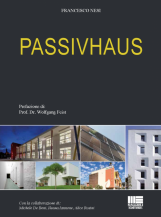
PASSIVHAUS
AUTHOR: Francesco Nesi
Passive House, Passivhaus, or EnerPHit? Residential or non-residential? New construction or renovation? These are just some of the questions to which this book tries to give an answer, starting from a technical and historical-normative point of view to deepen the backbones of building physics of the Passive House Standard.
Order the book here.
EnerPHit: A Step by Step Guide to Low Energy Retrofit
AUTHOR: James Traynor
In absence of a clear advice from the UK Government on how to reach the carbon zero target by 2050, "EnerPHit: A Step by Step Guide to Low Energy Retrofit" offers architects and policymakers a clear and practical understanding and methodology on how to best retrofit existing buildings in accordance with the EnerPHit energy performance standard. This guide backed with real-life case studies will provide readers key information on EnerPHit, the practical know-how and tips to ensure effective retrofit throughout all Plan of Work stages of a project to the EnerPHit standard.
Order the book here.

PHPP Illustrated: A Designer's Companion to the Passive House Planning Package
AUTHOR: Sarah Lewis
All architects hoping to design to the Passive House standard need to know how to use The Passive House Planning Package (PHPP).
This book provides much needed supplementary guidance for purchasers of the PHPP establishing the standard within the UK context and is a concise, user-friendly, highly illustrated step by step companion for practitioners and students who want to use the PHPP as a design tool. By improving their in-use understanding of the PHPP, this guide enables readers to fully comprehend their scheme in terms of the impact of orientation, envelope shape and ratio to floor area, fabric build-ups, fenestration ratio and shading effects on the energy balance – the essential criteria for all low energy buildings. Fully supported and endorsed by The Passivhaus Institut, the book will act as an invaluable gateway for brand new as well as more experienced PHPP users.
Order the book here.
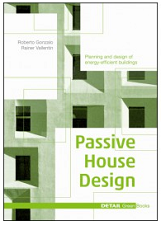
Passive House Design
AUTHOR: Roberto Gonzalo, Rainer Vallentin
“Passive House Design” gives readers confidence in dealing with the Passive House Standard from the very first design draft. It shows how much scope for design there is in Passive House buildings and explains design strategies that lead to better passive buildings. Detailed looks at both residential and non-residential buildings illustrate how Passive House integrates design, construction and building technology. Chapters on building physics, building services engineering, and energy balancing provide the detailed knowledge required to build. The book delves into project planning and energy balances, design strategies and construction methods, renovations with Passive House components and home automation. It also includes detailed reports of 14 built examples.
Order the book here.
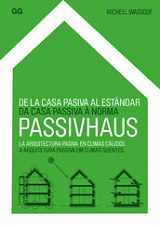
De la casa pasiva al estándar Passivhaus: La arquitectura pasiva en climas cálidos
AUTHOR: Micheel Wassouf
In "De la Casa Pasiva al Estándar Passivhaus" (both in Spanish and Portuguese), Micheel Wassouf describes Passive House principles, using traditional passive design strategies as well as current technological construction methods towards this internationally recognised building standard. The book describes Passive House solutions, focusing on hot climates and presenting the first built examples in Mediterranean and Latin-American regions. A special chapter describes how the PHPP can lead to a differentiated architecture, adapted to the climatic conditions of each site.
Note: It is worth mentioning that more recent studies have demonstrated the importance of airtightness for Passive Houses in temperate and warm climates. For tropical climates, airtightness has been proven to serve as a barrier against the high exterior humidity load in order to improve interior comfort and protect the building structure. To keep up-to-date with the latest trends, we recommend visiting Passipedia.
Nota: Cabe mencionar que en más recientes estudios se ha demostrado la importancia de la hermeticidad para edificios Passivhaus en climas templados y cálidos. También se ha comprobado que la hermeticidad en climas tropicales sirve para frenar la carga de humedad desde el exterior con el fin de mejorar el confort y proteger la estructura del edificio. Para estar al día de estas últimas tendencias, recomendamos visitar el sitio Passipedia.
Order the book from Editorial Gustavo Gili.
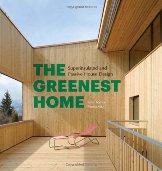
The Greenest Home: Superinsulated and Passive House Design
AUTHOR: Julie Torres Moskovitz
The Greenest Home showcases eighteen of the world's most attractive Passive Houses by forward-thinking architects such as Bernheimer Architecture, Olson Kundig Architects, and Onion Flats, among many others. Each case study consists of a detailed project description, plans, and photographs. An appendix lists helpful technical information. Including a mix of new construction and retrofit projects built in a variety of site conditions, The Greenest Home is an inspiring sourcebook for architects and prospective homeowners, as well as a useful tool for students, and builders alike.
The Greenest Home has been voted #6 in the Amazon Editor's Pick for 10 Best Architecture Books for 2013 and is available for purchase through amazon.com.

An Introduction to Passive House
AUTHOR: Justin Bere
Written by one of the UK's leading passive house architects, this book contains essays that reveal the technical and creative secrets of Passive House design, as well as containing case studies of some of the world's best examples of beautiful, technically excellent buildings that still feel great even when the power supply is turned down to almost nothing. Whether you are an architect, client, student or construction professional, this book is an enlightening introduction to Passive House and a valuable source of inspiration.
The 120 page book contains a foreword by Wolfgang Feist and is available through ribabookshops.com
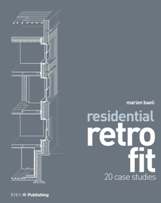
Residential Retrofit: 20 Case Studies
AUTHOR: Marion Baeli
This book presents a series of innovative and best practice case studies of residential low energy retrofit projects, and illustrates what has been achieved in practice in the UK.
Marion Baeli has received three awards for her work on 100 Princedale Road, the first retrofit in the UK to be certified to the full Passivhaus standard, and has spoken at conferences and seminars about her work on that project, and the lessons learned.
The 128 page book is available through ribabookshops.com.
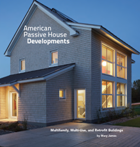
American Passive House Developments
AUTHOR: Mary James
Over the last two years, US architects and builders have scaled up and branched out when it comes to Passive House, using the approach to construct not just single family homes but also large multifamily, mixed-use, and commercial buildings—and often at no or a very small cost premium. Find out how in this design primer aimed at developers, builders, and architects of zero and near-zero energy buildings.

Passivhaus Handbook
RELEASED BY: Janet Cotterell and Adam Dadeby
The Passivhaus Handbook is an essential guide for everyone wanting to realise a supremely comfortable, healthy and durable home with exceptionally low energy costs. Whether you are building an extension, retrofitting your house or starting from scratch; are new to low-energy design or already have some experience, this book will help you navigate around the potential pitfalls and misconceptions. It brings together current thinking and best practice.
The book can be purchased here.
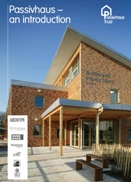
Passivhaus - An Introduction
RELEASED BY: Passivhaus Trust
The Trust has published a new introductory guide offering a brief introduction to Passivhaus principles and how the standard can be achieved. Featuring 12 Passivhaus certified projects, the guide also includes important information regarding costs of construction for various building typologies. Download Passivhaus Intro Guide here [PDF 1.0MB] or directly from the Passivhaus Trust website
Passivhaus Primers
RELEASED BY: BRE
The UK Building Research Establishment (BRE) has released three "Passivhaus Primers", providing an overview of the Passive House concept, aimed at different target groups and levels of expertise.
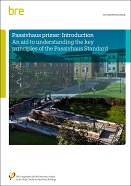
Passivhaus Primer: Introduction
An aid to understanding the key principles of the Passivhaus standard
The introduction primer will give you a basic understanding of the key principles of the Passivhaus standard.
Download the introduction primer here [PDF 1.1MB] or directly from the BRE website
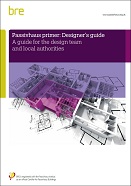
Passivhaus Primer: Designer's Guide
A guide for the design team and local authorities
This designer primer will provide a basic understanding of the process and application of Passivhaus design.
Download the design primer here [PDF 1.4MB] or directly from the BRE website
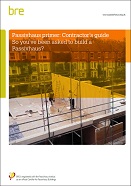
Passivhaus Primer: Contractor's Guide
So you've been asked to build a Passivhaus?
The contractor’s guide addresses the issues that building contractors face when tasked with a Passivhaus project and gives simple advice and tips on how to deliver a successful outcome.
Download the contractor's primer here [PDF 1.9MB] or directly from the BRE website
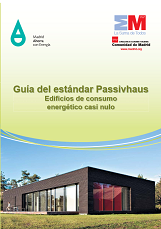
SPANISH PASSIVE HOUSE GUIDE: Guía del estándar Passivhaus - Edificios de consumo energético casi nulo
BY: Fundación de la Energía de la Comunidad de Madrid
La Consejería de Economía y Hacienda, a través de la Dirección General de Industria, Energía y Minas, y de la Fundación de la Energía de la Comunidad de Madrid, con la colaboración de la Plataforma de Edificación Passivhaus, y dentro de la campaña Madrid Ahorra con Energía, lleva a cabo el desarrollo de esta guía con el fin de dar a conocer este concepto ampliamente instalado en Europa y el cual representa el futuro en el desarrollo de edificios de consumo casi nulo, debido a que el 40% de la energía consumida en Europa corresponde a los edificios existentes.
For more information, visit www.fenercom.com |Download the Guía here (PDF, 3MB)
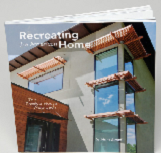
Recreating the American Home: The Passive House Approach
BY: MARY JAMES
From steamy Louisiana to snowy Wisconsin, and from Brooklyn brownstones to western Marin County bungalows, Passive Houses are being created in a wide range of climate and building types across the United States. Recreating the American Home: The Passive House Approach with foreword by Jonah Stanford showcases 10 recently constructed Passive House projects across the country. With its mix of new construction and retrofit projects in a variety of climate types, Recreating the American Home provides concrete examples of elegant, energy-efficient housing solutions for architects, builders, and homeowners everywhere. Order here
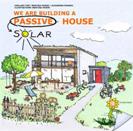
CHILDREN'S BOOK: We are building a solar house
IDEA AND TEXT: MARTINA FEIRER / ALEXANDRA FRANKEL
This book for 5 to 10 year-olds explains, in a simple and playful way, how a Passive House works and why it makes sense to build with the environment and energy use in mind. Appropriate for schools and kindergartens as well as for child-oriented environmental education projects.
20 pages with foldout pictures and moveable parts
Privately published in 2007
Unit price: €19.50
Currently available in English, German, Rhaeto-Romanic, Italian and French.
English edition: Order here
German edition: Order here
Rhaeto-Romanic, Italian and French edition: Order here
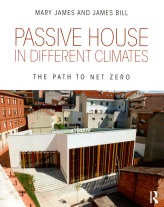
Passive House in Different Climates
Passive House in Different Climates introduces the seven Passive House principles, to help you create super-insulated, airtight buildings that require minimal energy use to heat, cool, dehumidify, and ventilate, with superior indoor air quality and year-round comfort. Seventeen case studies in four climate zones---marine, cold and very cold, mixed-dry and hot-dry, and mixed-humid and hot-humid---and in ten countries, show you how to achieve net-zero energy regardless of where you’re building or what type of building is required. Includes more than 150 color illustrations.




